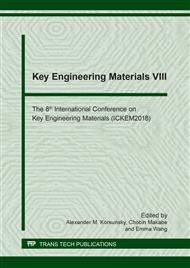[1]
U. Aliyu, U. El-Nafaty, and I. Muhammad, Oil removal from crude oil polluted water using banana peel as sorbent in a packed column,, Journal of Natural Sciences Research, vol. 5, pp.157-162, (2015).
Google Scholar
[2]
D. Dave and A. E. Ghaly, Remediation technologies for marine oil spills: A critical review and comparative analysis,, American Journal of Environmental Sciences, vol. 7, p.423, (2011).
DOI: 10.3844/ajessp.2011.423.440
Google Scholar
[3]
F. J. Caldeira, M. Petrič, and M. Humar, Towards Forest Products and Processes with Lower Environmental Impact: University Fernando Pessoa, (2014).
Google Scholar
[4]
A. Bhatnagar and M. Sillanpää, Utilization of agro-industrial and municipal waste materials as potential adsorbents for water treatment—a review,, Chemical Engineering Journal, vol. 157, pp.277-296, (2010).
DOI: 10.1016/j.cej.2010.01.007
Google Scholar
[5]
A. Bhatnagar and A. Minocha, Adsorptive removal of 2, 4-dichlorophenol from water utilizing Punica granatum peel waste and stabilization with cement,, Journal of hazardous materials, vol. 168, pp.1111-1117, (2009).
DOI: 10.1016/j.jhazmat.2009.02.151
Google Scholar
[6]
R. Wahi, L. A. Chuah, T. S. Y. Choong, Z. Ngaini, and M. M. Nourouzi, Oil removal from aqueous state by natural fibrous sorbent: an overview,, Separation and Purification Technology, vol. 113, pp.51-63, (2013).
DOI: 10.1016/j.seppur.2013.04.015
Google Scholar
[7]
C. L. Ramsey, S. Jose, D. L. Miller, J. Cox, K. M. Portier, D. G. Shilling, and S. Merritt, Cogongrass [Imperata cylindrica (L.) Beauv.] response to herbicides and disking on a cutover site and in a mid-rotation pine plantation in southern USA,, Forest Ecology and Management, vol. 179, pp.195-207, (2003).
DOI: 10.1016/s0378-1127(02)00515-7
Google Scholar
[8]
A. S. M. Kassim, A. M. Aripin, N. Ishak, N. H. H. Hairom, N. A. Fauzi, N. F. Razali, and M. H. Zainulabidin, Potential of cogon grass (Imperata Cylindrica) as an alternative fibre in paper-based industry,, (2006).
DOI: 10.4028/www.scientific.net/amm.773-774.1242
Google Scholar
[9]
M. A. M. Hanafiah, M. Z. Yahya, H. Zakaria, and S. Ibrahim, Adsorption of Cd (II) ions from aqueous solutions by Lalang (Imperata cylindrica) leaf powder: Effect of physicochemical environment,, Journal of Applied Sciences, vol. 7, pp.489-493, (2007).
DOI: 10.3923/jas.2007.489.493
Google Scholar
[10]
C. X.-H. Su, T. T. Teng, A. F. Alkarkhi, and L. W. Low, Imperata Cylindrica (Cogongrass) as an adsorbent for methylene blue dye removal: Process optimization,, Water, Air, & Soil Pollution, vol. 225, p.1941, (2014).
DOI: 10.1007/s11270-014-1941-x
Google Scholar
[11]
K.-W. Kow, R. Yusoff, A. A. Aziz, and E. Abdullah, Characterisation of bio-silica synthesised from cogon grass (Imperata cylindrica),, Powder Technology, vol. 254, pp.206-213, (2014).
DOI: 10.1016/j.powtec.2014.01.018
Google Scholar
[12]
Y. Y. a. H. Liong, Rasmina and Mohamed, Rozi, Chemical Characterization of Imperata cylindrica ('Lalang') and Pennisetum purpureum (Napier grass) for Bioethanol Production in Malaysia,, Pertanika Journal of Tropical Agricultural Science, vol. 36, pp.109-116, (2013).
Google Scholar
[13]
S. K. Wiśniewska, J. Nalaskowski, E. Witka-Jeżewska, J. Hupka, and J. D. Miller, Surface properties of barley straw,, Colloids and Surfaces B: Biointerfaces, vol. 29, pp.131-142, (2003).
DOI: 10.1016/s0927-7765(02)00178-9
Google Scholar
[14]
M. Ahmedna, M. Johns, S. Clarke, W. Marshall, and R. Rao, Potential of agricultural by‐product‐based activated carbons for use in raw sugar decolourisation,, Journal of the Science of Food and Agriculture, vol. 75, pp.117-124, (1997).
DOI: 10.1002/(sici)1097-0010(199709)75:1<117::aid-jsfa850>3.0.co;2-m
Google Scholar
[15]
T. Dong, G. Xu, and F. Wang, Oil spill cleanup by structured natural sorbents made from cattail fibers,, Industrial Crops and Products, vol. 76, pp.25-33, (2015).
DOI: 10.1016/j.indcrop.2015.06.034
Google Scholar
[16]
Y. Feng, W. Yang, and W. Chu, Contribution of ash content related to methane adsorption behaviors of bituminous coals,, International Journal of Chemical Engineering, vol. 2014, (2014).
DOI: 10.1155/2014/956543
Google Scholar
[17]
D. Malik, C. Jain, A. K. Yadav, and G. K. Vishwavidyalaya, Preparation and characterization of plant based low cost adsorbents,, Journal of global bioscience, vol. 4, pp.1824-1829, (2015).
Google Scholar
[18]
M. Inagaki, A. Kawahara, and H. Konno, Sorption and recovery of heavy oils using carbonized fir fibers and recycling,, Carbon, vol. 40, pp.105-111, 2002/01/01/ (2002).
DOI: 10.1016/s0008-6223(01)00083-5
Google Scholar
[19]
F. A. Dawodu and K. G. Akpomie, Simultaneous adsorption of Ni (II) and Mn (II) ions from aqueous solution unto a Nigerian kaolinite clay,, Journal of materials research and technology, vol. 3, pp.129-141, (2014).
DOI: 10.1016/j.jmrt.2014.03.002
Google Scholar
[20]
A. Pérez-Marín, V. M. Zapata, J. Ortuno, M. Aguilar, J. Sáez, and M. Lloréns, Removal of cadmium from aqueous solutions by adsorption onto orange waste,, Journal of hazardous materials, vol. 139, pp.122-131, (2007).
DOI: 10.1016/j.jhazmat.2006.06.008
Google Scholar


